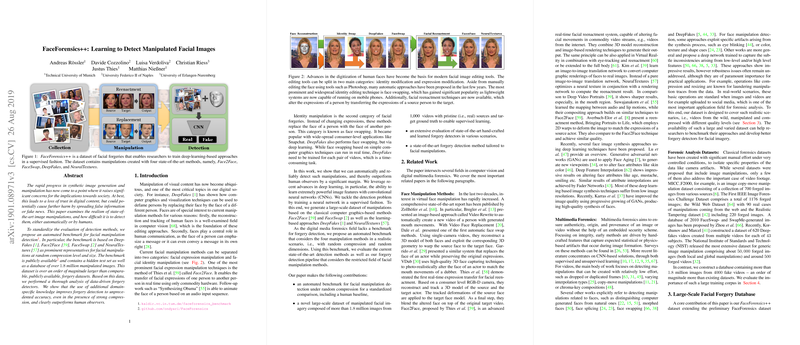Insights into "FaceForensics++: Learning to Detect Manipulated Facial Images"
"FaceForensics++" by Rössler et al. addresses the increasingly pertinent task of detecting manipulated facial images, a domain that has intensified with the proliferation of sophisticated image synthesis and manipulation techniques. The paper centers on evaluating current capabilities in detecting various forms of facial forgeries, proposing a novel dataset and benchmark to standardize the assessment of detection methodologies.
Contributions and Methodologies
The paper makes several significant contributions:
- Automated Benchmark Proposal: The authors introduce an automated benchmark to evaluate the realism and detectability of facial manipulations. This benchmark is particularly notable for incorporating manipulations created by state-of-the-art methods, such as DeepFakes, Face2Face, FaceSwap, and NeuralTextures (NT), under varying compression levels and dimensions.
- Large-scale Manipulation Dataset: A salient feature of the paper is the FaceForensics++ dataset. Comprising over 1.8 million manipulated images from 4,000 videos, it provides a substantial resource for training and evaluating deep-learning-based forgery detection approaches. This dataset surpasses existing forgery datasets by an order of magnitude in size and diversity.
- Forgery Detection Pipeline: Leveraging convolutional neural networks (CNNs), the authors redefine forgery detection with a focus on domain-specific knowledge, particularly the use of face tracking to extract relevant facial regions before classification. The results indicate that this approach significantly enhances detection performance.
- Extensive Evaluation: The paper includes a thorough analysis of both hand-crafted and learned forgery detectors. It demonstrates that deep learning methods, notably XceptionNet, achieve superior accuracy in detecting manipulations, particularly in compressed videos, compared to human observers.
Findings and Numerical Results
The core findings of the paper highlight:
- Human vs. Automated Detection: The user paper with 204 participants revealed that human observers exhibit an accuracy around 68.7% for raw videos, dropping to 58.7% for low-quality compressed videos. In contrast, the best automated system, XceptionNet, achieved 99.26% accuracy on raw images and maintained a commendable 81.00% for low-quality images.
- Impact of Dataset Size: The paper underscored the critical importance of large training datasets. The XceptionNet's performance notably increased, particularly for low-quality videos, as the training corpus size expanded, underscoring the dataset's value.
- Detection Robustness: Methods like NeuralTextures, which introduce fewer semantic changes and subtler artifacts, were particularly challenging. Despite these difficulties, the automated methods trained on the dataset were able to outperform human observers in detecting these forgeries.
Implications and Future Directions
The implications of this research are multi-faceted:
- Enhanced Trust in Digital Media: By improving the accuracy and robustness of forgery detection methods, this research has the potential to restore trust in digital media. This is crucial in mitigating the spread of misinformation and fake news facilitated by manipulated content.
- Benchmarking and Standardization: The proposed automated benchmark and dataset set a new standard for the evaluation of forgery detection methods. This could drive more consistent and comparable research outputs within the scientific community.
- Transfer Learning: Future research could explore the transferability of models trained on the FaceForensics++ dataset to detect new and emerging types of manipulations. This aspect is critical given the perpetual advancement in manipulation techniques.
- Real-World Applications: The findings encourage the integration of robust forgery detection systems in social media platforms and other digital media repositories to automatically screen and flag potentially manipulated content.
Conclusion
"FaceForensics++" provides a comprehensive and rigorous approach to detecting manipulated facial images, advancing both the theoretical framework and practical capabilities in digital media forensics. By making the dataset and benchmark publicly available, the authors have laid a solid foundation for future research and application in this critical domain. Given the ongoing evolution of image manipulation techniques, the methodologies and findings of this paper will have enduring relevance and utility in enhancing digital content authenticity.
